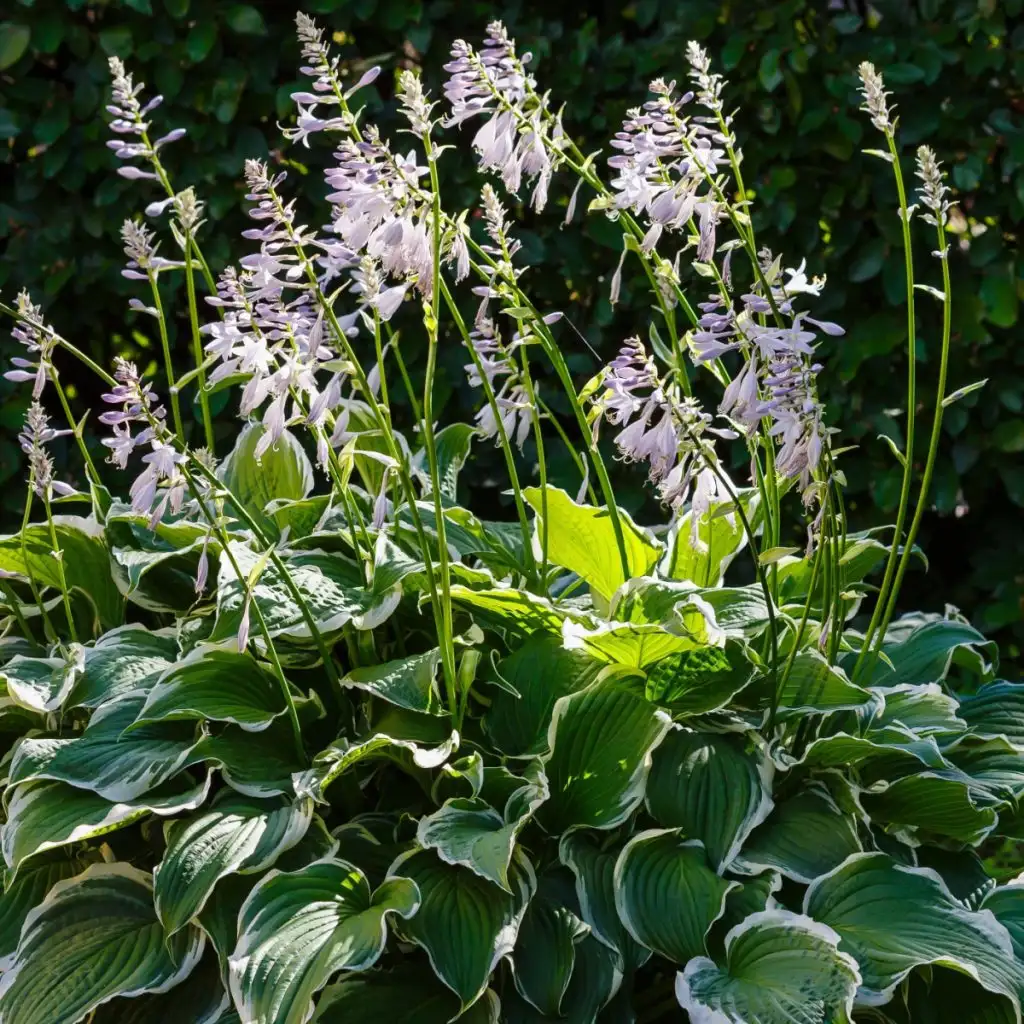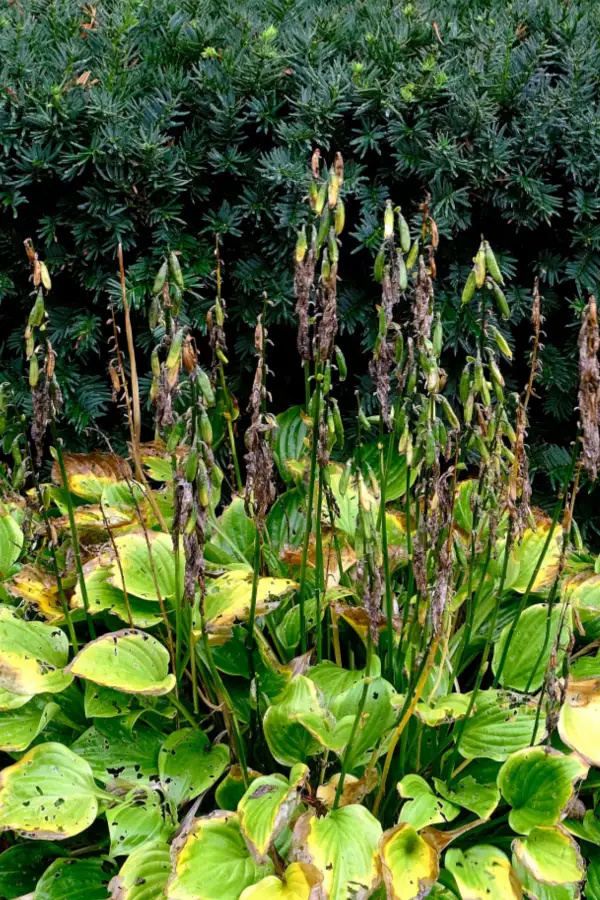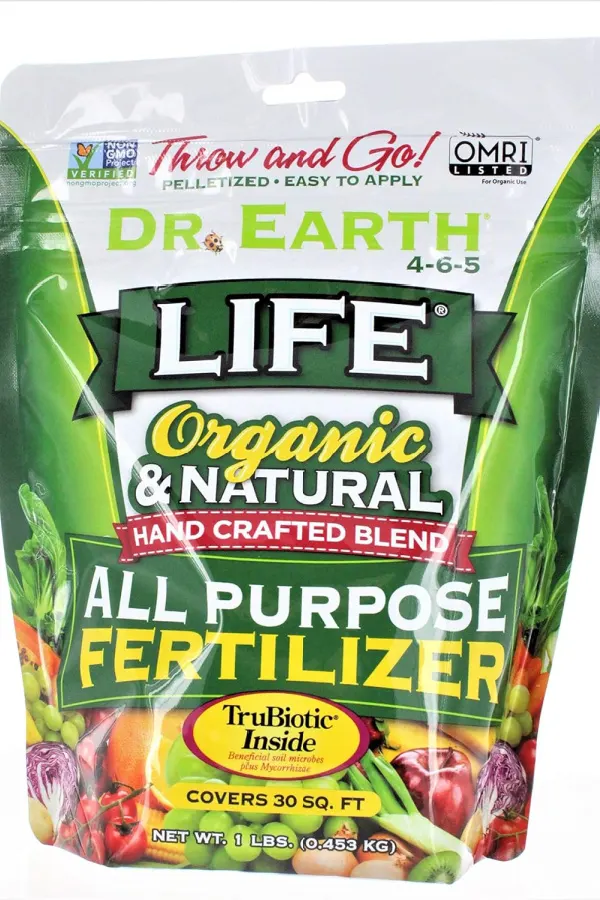Wondering what you need to do with your hostas this summer after they bloom to help keep their leaves bright, green and beautiful the rest of the growing season?
Hostas are one of the most popular perennials for shade gardens. Their large, lush leaves bring a lot of life to flowerbeds and the landscape. And while their flowers can be beautiful too, blooming takes quite a toll on the plants. Especially when it comes to just how vibrant and green their leaves stay late into the summer months
Once hostas finish blooming, they can begin to look a little worn out. Their leaves can start to become ragged, yellow and brown on the edges – and the plant often begins to lose its luster, leaving your flowerbeds less than attractive. But here’s the good news – it doesn’t have to be that way!

As it turns out, how you care for hostas right after they bloom can make a big difference in their overall health and appearance for the remainder of the growing season. And by simply performing two simple tasks – deadheading the spent blooms and giving your plants a light summer feeding – you can restore your hostas’ beauty all the way into late fall!
What To Do With Hostas After They Bloom
Deadheading Spent Hosta Blooms After Flowering
Once hostas send up their flower stalks and go through their blooming cycle, they will begin to naturally weaken. The process of flowering requires a lot of energy. Just like any other plant, producing blooms drains the hosta of the strength it normally puts into growing and maintaining its foliage.
Because of that, one of the most important things you can do right after your hostas bloom is to remove those old flower stalks. This process is called deadheading. Once the flowers begin to fade and dry out, they no longer serve any purpose for the plant. In fact, if you leave them in place, the plant will continue to send energy into the flower stalk and try to produce seeds.
The simple fact is, if you want your hostas to put their energy back into growing strong, lush foliage, cutting off the flower stalks is essential. And pruning them back couldn’t be easier!
To cut back, simply use a pair of sharp garden scissors or pruners. Cut each flower stalk off near the base of the plant. Cut the stalk as low as you can, but be sure not to cut into the crown or leaves. As soon as you do, the plant will begin to redirect its energy back into growing leaves.

Feeding Hostas After They Bloom
Even though deadheading conserves a great deal of energy for the plant, your hosta plants have still lost a lot of nutrients through the entire flowering process. But that is where fertilizing can save the day.
A great way to help perk up hostas after they flower is to apply a light dose of fertilizer. Hostas don’t require heavy feeding, but a balanced granular fertilizer in or near the 5-5-5 range works well after bloom time. Affiliate Link: Dr. Earth 91164 1 lb. 5-6-5 MINIS Life All Purpose Fertilizer
These numbers refer to the amounts of nitrogen, phosphorus, and potassium in the fertilizer. A balanced fertilizer helps promote healthy root growth, stronger foliage, and general plant health. It’s best to use a slow-release granular fertilizer at this time so that the nutrients feed the plant gently and over time.
To apply, lightly sprinkle the fertilizer around the base of the plant, keeping it away from the crown. A good rule of thumb is to apply 1 tablespoon of fertilizer per plant. For overly large plants, you can double the dose.
It’s always best to water the area well after applying to help the fertilizer soak into the soil. One feeding right after bloom is usually enough to restore your hostas and keep them looking good the rest of the season.
If you prefer, you can also use compost or compost tea instead. A thin layer of compost around the base of the plant can provide a slow, steady supply of nutrients and also help retain moisture in the soil. Likewise, a few doses of compost tea will help to re-power the roots and foliage of hostas.
Dividing Overgrown Hostas in Summer
Most people divide hostas in early spring or late fall. But if you have a large hosta that’s taking up too much space or looking a bit overcrowded, you can actually divide it during the summer too. It may seem surprising, but summer division works very well. Especially right after flowering when the plant has already used a lot of its energy and might be slowing down.
Dividing large hostas can also help prevent overcrowding, which can lead to disease or poor airflow. Plus, it’s a great way to multiply your plants and fill in other parts of your flowerbeds. All without having to buy new ones!
To divide, start by digging up the entire hosta plant, trying to keep as much of the root ball intact as possible. Then, use a sharp spade or knife to split the root mass into two or more sections. Each section should have at least two to three inches of roots. You can cut back the foliage to within a few inches of the roots.
Replant the divided sections immediately and water them well. It’s also a good idea to add a bit of mulch to help keep the soil cool and moist. Once replanted, the new division will put on fresh, new growth before the end of the season. Even better, they will be ready to take off strong again next spring.

What To Do If Your Hostas Have Been Destroyed By Pests In The Summer
Sometimes, it’s hard to keep hostas healthy in the summer after they bloom because of pests. Unfortunately, hostas are a favorite snack for deer, slugs, and other garden pests. See our article: How To Keep Hostas Safe From Insects, Deer & More.
If your hosta leaves have been badly chewed up and are no longer attractive, you can actually cut the entire plant back to the ground and let it regrow. This may seem a little extreme, but hostas are very resilient. Cutting the damaged leaves back allows the plant to produce new, healthy foliage.
To do this, take clean, sharp scissors or garden shears and trim all the foliage down close to the base of the plant, being careful not to damage the crown. Once the damaged foliage is removed, water the plant well and add a thin layer of compost or mulch.
In about two to three weeks, you’ll start to see new leaves emerging from the center. By late summer or early fall, your hostas will be full, lush, and beautiful again.
Keeping Hostas Healthy Through Summer
Along with trimming and fertilizing after blooming, there are a few more things you can do to keep your hostas looking their best through the summer months. First, make sure they’re getting enough water. Hostas like consistently moist soil, especially during hot weather. A deep watering once or twice a week is better than frequent shallow watering.
Mulching around your hostas can help keep the soil moist and cool. Especially in the heat of summer. It also helps reduce weed growth, which can compete with them for water and nutrients. Also, remove any dead or damaged leaves as you notice them throughout the season.
Keeping the plant tidy not only improves the look of your garden but also helps prevent pests and disease from taking hold. Whether it’s cutting back blooms, feeding, dividing, or refreshing their foliage, with just a few simple tasks after your hostas bloom, you can keep your hostas looking great all season long! For even more tips on keeping your hostas thriving, see our article: How To Divide Hostas In Late Fall – Create New Plants For Free! And for more tips on keeping perennials healthy, see: What To Do When Coneflower Plants Finish Blooming – When & How To Cut Back Coneflower! and 3 Popular Perennials You Can Divide In The Middle Of Summer – And Create More Plants For Free!
This Is My Garden
Follow Our Facebook Page For Great Gardening Tips And Advice! This Is My Garden Facebook Page
This Is My Garden is a garden website created by gardeners, for gardeners. Jim and Mary Competti have been writing gardening, DIY and recipe articles and books and speaking for over 15 years from their 46 acre Ohio farm. They publish three articles every week, 52 weeks a year. Sign up today to follow via email, or follow along!

